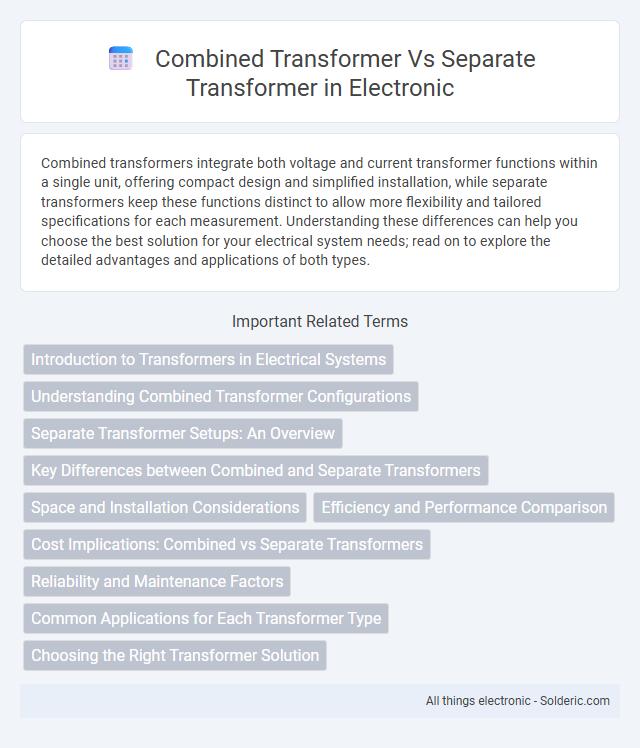Combined transformers integrate both voltage and current transformer functions within a single unit, offering compact design and simplified installation, while separate transformers keep these functions distinct to allow more flexibility and tailored specifications for each measurement. Understanding these differences can help you choose the best solution for your electrical system needs; read on to explore the detailed advantages and applications of both types.
Comparison Table
| Feature | Combined Transformer | Separate Transformer |
|---|---|---|
| Architecture | Single model processes multiple tasks or data types together | Individual models handle each task or data type separately |
| Parameter Efficiency | Shares parameters across tasks, reducing model size | Separate parameters per task, larger overall size |
| Training Complexity | Requires multi-task learning techniques, potentially complex | Simpler task-specific training |
| Inference Speed | Faster inference when handling multiple tasks simultaneously | Slower if tasks run sequentially or models are queried separately |
| Flexibility | Less flexible to add new tasks without retraining the whole model | Modular, easy to add or update tasks independently |
| Use Cases | Multi-task learning, joint representations | Task-specific applications, modular system design |
Introduction to Transformers in Electrical Systems
Transformers in electrical systems serve the critical function of voltage regulation through electromagnetic induction, enabling efficient power transmission and distribution. Combined transformers integrate multiple winding functions within a single core structure, enhancing space utilization and reducing material costs compared to separate transformers that consist of distinct units for each winding. The choice between combined and separate transformers impacts system complexity, maintenance, and overall efficiency in power networks.
Understanding Combined Transformer Configurations
Combined transformer configurations integrate both power and distribution transformer functionalities into a single unit, optimizing space and reducing installation costs. Your electrical system benefits from enhanced efficiency and simplified maintenance compared to separate transformer setups, which require distinct units for each function. Understanding these configurations helps in selecting the appropriate solution for load requirements and improved overall system reliability.
Separate Transformer Setups: An Overview
Separate transformer setups consist of distinct modules for the encoder and decoder, each optimized for specific tasks such as input representation and output generation. This configuration allows for specialized training and fine-tuning, improving model interpretability and enabling efficient error analysis. You can leverage these benefits to tailor each component individually, enhancing overall system performance in tasks like machine translation or sequence generation.
Key Differences between Combined and Separate Transformers
Combined transformers integrate multiple functions such as voltage transformation and isolation within a single unit, enhancing efficiency and reducing installation space. Separate transformers perform distinct roles individually, offering greater flexibility in system design and easier maintenance. Your choice between combined and separate transformers depends on factors like space constraints, system complexity, and maintenance preferences.
Space and Installation Considerations
Combined transformers save space by integrating multiple windings into a single unit, reducing the footprint needed compared to separate transformers. Installation of combined transformers is streamlined, requiring fewer mounting points and less cabling, which simplifies setup and maintenance processes. Separate transformers, while offering modular flexibility, typically demand more physical space and complex wiring arrangements, increasing overall installation time and costs.
Efficiency and Performance Comparison
A combined transformer architecture integrates multiple tasks into a single model, resulting in improved computational efficiency by sharing parameters and reducing redundant computations. Separate transformers allocate dedicated resources for each task, often leading to higher performance in specialized applications but at the expense of increased memory usage and longer training times. Your choice between combined or separate transformers should balance the need for efficiency with the desired level of task-specific accuracy.
Cost Implications: Combined vs Separate Transformers
Combined transformers typically reduce installation and maintenance costs by integrating multiple voltage levels into a single unit, minimizing space and equipment requirements. Separate transformers, while offering tailored performance for specific voltage levels, often lead to higher overall expenses due to increased material, labor, and space needs. You can optimize your electrical infrastructure expenses by evaluating the cost benefits of combined transformers against the flexibility of separate units.
Reliability and Maintenance Factors
Combined transformers offer enhanced reliability by eliminating the need for multiple units, reducing potential failure points and simplifying maintenance routines. Separate transformers require more frequent inspections and upkeep due to the increased number of components and connections, which can lead to higher downtime and maintenance costs. Your choice should consider the operational environment and maintenance capabilities to optimize transformer longevity and system reliability.
Common Applications for Each Transformer Type
Combined transformers are commonly used in applications requiring compact design and simplified installation, such as residential power distribution and small commercial buildings. Separate transformers are preferred in industrial settings and large-scale power systems where customized voltage regulation and enhanced fault isolation are critical. Your choice depends on the specific voltage needs, space constraints, and system complexity of the application.
Choosing the Right Transformer Solution
Choosing the right transformer solution depends on the specific application's voltage regulation, efficiency, and physical space requirements. Combined transformers integrate multiple functions into a single unit, offering compact design and reduced installation costs, while separate transformers provide greater flexibility and easier maintenance by isolating different voltage stages. Evaluating load characteristics and operational environment ensures optimal performance when deciding between combined versus separate transformer configurations.
combined transformer vs separate transformer Infographic

 solderic.com
solderic.com